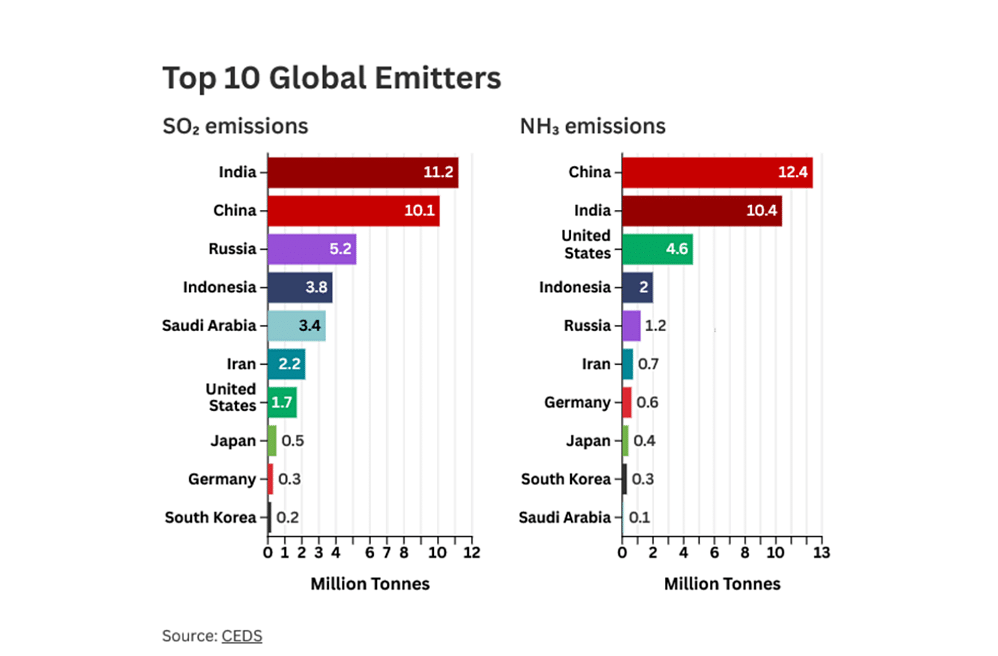Secondary Pollutants Account for One-Third of India's PM2.5 Pollution: CREA
New analysis reveals ammonium sulfate from coal plants drives nationwide air quality crisis.
Secondary pollutants, particularly ammonium sulfate formed from atmospheric reactions between sulfur dioxide and ammonia, account for nearly one-third of India's fine particulate matter pollution, according to a new analysis released Thursday by the Centre for Research on Energy and Clean Air. The study found that coal-fired thermal power plants, which generate more than 60 percent of the country's sulfur dioxide emissions, represent the primary source of these harmful secondary particles that affect air quality across state boundaries.
The nationwide average concentration of ammonium sulfate measures 11.9 micrograms per cubic meter, representing approximately 34 percent of total PM2.5 mass. This widespread presence has been documented across nearly all National Clean Air Programme cities, regardless of their proximity to major emission sources, due to the transboundary nature of the pollution.
Coal-fired power plants demonstrate significant local impact, with ammonium sulfate concentrations reaching 15 micrograms per cubic meter within 10 kilometers of these facilities, compared to 6 micrograms per cubic meter in areas beyond this radius. The contribution to PM2.5 levels stands at 36 percent near thermal power plants and remains substantial at 23 percent in other areas, indicating both local and regional impacts of sulfur dioxide emissions.
Across the 130 NCAP cities examined, ammonium sulfate concentrations ranged from 3.9 to 22.5 micrograms per cubic meter, with contributions to total PM2.5 mass varying between 20 and 43 percent. The analysis revealed that 114 out of 130 cities recorded ammonium sulfate contributions exceeding 30 percent of their total PM2.5 levels.

The five cities with the highest ammonium sulfate concentrations include Patna at 22.5 micrograms per cubic meter, followed by Muzaffarpur, Kolkata, and Howrah at 21.7 micrograms per cubic meter each, and Varanasi at 21.6 micrograms per cubic meter. Cities with the highest percentage contributions include Korba at 43.1 percent, Bhilai at 42.5 percent, and Anpara at 42.3 percent.
The transboundary nature of secondary pollution presents particular challenges for air quality management. These particles can travel across city and state boundaries, affecting regions far from original emission sources. This phenomenon means that cities without large local emission sources may still experience elevated PM2.5 levels due to secondary particle transport.
India ranks as the world's largest emitter of sulfur dioxide at 11.2 million tonnes annually and second globally in ammonia emissions at 10.4 million tonnes. These elevated levels create conditions conducive to widespread secondary pollutant formation, including sulfate, nitrate, and ozone compounds.
The current National Clean Air Programme primarily targets PM10 reduction and focuses on primary pollutant sources. However, PM2.5 poses greater health risks as these particles penetrate deeper into lungs and enter the bloodstream, increasing risks of cardiovascular disease, respiratory disorders, and premature mortality.
The study indicates that secondary particles can account for up to 50 percent of total PM2.5 mass when including other compounds such as ammonium nitrate. This finding underscores the limitations of current approaches that concentrate primarily on direct emission sources such as vehicular exhaust, construction dust, and open burning.
Coal-fired thermal power plants emerge as critical intervention points, contributing approximately 4.3 million tonnes of sulfur dioxide annually. This volume exceeds the total national sulfur dioxide emissions of several major emitting countries, including Indonesia, which ranks fourth globally.
The analysis recommends that clean air action plans explicitly address major sources of precursor gases responsible for secondary particulate matter formation. Specific measures include implementing flue gas desulfurization systems in coal-fired thermal power plants, promoting efficient fertilizer management practices, and ensuring compliance with existing emission standards across all polluting sectors.
"Alongside targeted strategies such as deploying flue-gas desulfurization in coal-fired thermal power plants to reduce sulfur dioxide and promoting efficient fertilizer management to reduce ammonia, it is essential that all polluting sectors fully comply with existing emission norms. Ensuring both source-specific actions and regulatory compliance is critical for reducing precursor gas emissions and tackling the growing burden of secondary PM2.5 pollution in India," said Manoj Kumar, Analyst at CREA.
The research utilized satellite-based reanalysis data from the Modern-Era Retrospective analysis for Research and Applications, Version 2, to examine ammonium sulfate distribution patterns across India, around coal-fired thermal power plants, and within NCAP cities.
The findings suggest that effective air pollution control requires a fundamental shift from current strategies focused primarily on visible, directly-emitted pollutants toward comprehensive approaches that address precursor gases and secondary particle formation processes. Without such measures, the study indicates that India's air pollution challenge cannot be effectively resolved.
RELATED ARTICLES
Kia India Launches Nationwide Ownership Service Camp Across 329 Cities
Running until July 1, 2025, the service camp covers 445 workshops and offers discounts on services, accessories, and war...
Government Issues Notification to Mandate ABS, 2 Helmets in All 2-wheelers
Anti-lock Braking System (ABS) will become mandatory for all two-wheelers manufactured from January 1.
Vedanta Metal Bazaar Records Rs 40,000 Crore in Total Sales on National MSME Day
The platform, now serving 60% MSMEs, simplifies non-ferrous metal procurement with real-time tracking, hedging tools, fl...





 By Shruti Shiraguppi
By Shruti Shiraguppi
 27 Jun 2025
27 Jun 2025
 244 Views
244 Views





 Sarthak Mahajan
Sarthak Mahajan


 Kiran Murali
Kiran Murali


